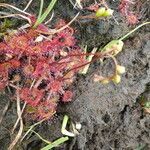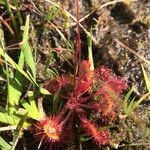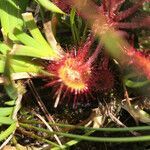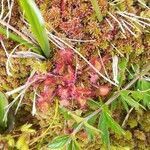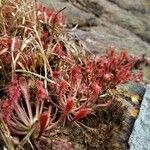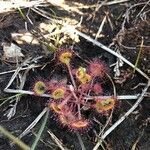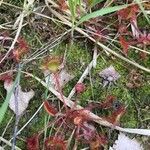Plants forming winter hibernaculae, rosettes (2–)4–10(–15) cm diam.; stem base not bulbous-cormose. Leaves erect to prostrate; stipules adnate to petioles their entire length, 4–6 mm, margins fimbriate along distal 1/2; petiole differentiated from blade, 1.5–5 cm, glandular-pilose; blade suborbiculate, 0.4–1 cm × 5–12 mm, <broader than long, much shorter than petiole>. Inflorescences 2–15(–25)-flowered; scapes 5–35 cm, glabrous. Flowers 4–7 mm diam.; sepals connate basally, oblong, 4–5 × 1.5–2 mm, glabrous; petals white or pink, spatulate, 5–6 × 3 mm. Capsules 5 mm. Seeds light brown, fusiform, 1–1.5 mm, finely and regularly longitudinally striate, <with metallic sheen>. 2n = 20.
Petioles 1.5–5 cm, flat, glandular-hairy; lf-blades 4–10 mm, broader than long, much shorter than the petiole; stipules 4–6 mm, adnate, fimbriate along the upper half, scape glabrous, 7–35 cm, with 3–15 fls 4–7 mm wide; sep 4–5 mm; pet white to pink, spatulate, longer than the sep; seeds light brown, lustrous, 1–1.5 mm, sigmoid-fusiform, finely and regularly striate longitudinally; 2n=20. Common in bogs and swamps; circumboreal, in Amer. s. to S.C., Ga., Tenn., Ill., and Calif. June–Sept.
A small herb. It forms rings or leaves. It can be an annual or keep growing from year to year. It grows 5-10 cm high and spreads 10 cm wide. The leaves are cup shaped and on fine stalks. The flowers are very small and white or pink. They have 5 petals. They are on a leafless stalk. The fruit are capsules of winged seeds.

